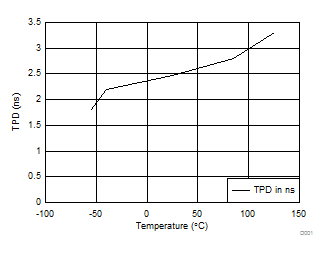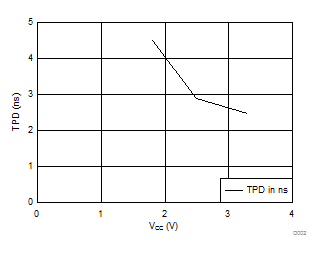SCAS757B December 2003 – September 2014 SN74LVCH16374A
PRODUCTION DATA.
- 1 Features
- 2 Applications
- 3 Simplified Schematic
- 4 Revision History
- 5 Pin Configuration and Functions
- 6 Specifications
- 7 Detailed Description
- 8 Application and Implementation
- 9 Power Supply Recommendations
- 10Layout
- 11Device and Documentation Support
- 12Mechanical, Packaging, and Orderable Information
Package Options
Mechanical Data (Package|Pins)
Thermal pad, mechanical data (Package|Pins)
Orderable Information
6 Specifications
6.1 Absolute Maximum Ratings
over operating free-air temperature range (unless otherwise noted)(1)| MIN | MAX | UNIT | |||
|---|---|---|---|---|---|
| VCC | Supply voltage range | –0.5 | 6.5 | V | |
| VI | Input voltage range(2) | –0.5 | 6.5 | V | |
| VO | Voltage range applied to any output in the high-impedance or power-off state(2) | –0.5 | 6.5 | V | |
| VO | Voltage range applied to any output in the high or low state(2)(3) | –0.5 | VCC + 0.5 | V | |
| IIK | Input clamp current | VI < 0 | –50 | mA | |
| IOK | Output clamp current | VO < 0 | –50 | mA | |
| IO | Continuous output current | ±50 | mA | ||
| Continuous current through VCC or GND | ±100 | mA | |||
(1) Stresses beyond those listed under Absolute Maximum Ratings may cause permanent damage to the device. These are stress ratings only, and functional operation of the device at these or any other conditions beyond those indicated under Recommended Operating Conditions is not implied. Exposure to absolute-maximum-rated conditions for extended periods may affect device reliability.
(2) The input negative-voltage and output voltage ratings may be exceeded if the input and output current ratings are observed.
(3) The value of VCC is provided in the Recommended Operating Conditions table.
6.2 Handling Ratings
| MIN | MAX | UNIT | |||
|---|---|---|---|---|---|
| Tstg | Storage temperature range | –65 | 150 | °C | |
| V(ESD) | Electrostatic discharge | Human body model (HBM), per ANSI/ESDA/JEDEC JS-001, all pins(1) | 0 | 2000 | V |
| Charged device model (CDM), per JEDEC specification JESD22-C101, all pins(2) | 0 | 1000 | |||
(1) JEDEC document JEP155 states that 500-V HBM allows safe manufacturing with a standard ESD control process.
(2) JEDEC document JEP157 states that 250-V CDM allows safe manufacturing with a standard ESD control process.
6.3 Recommended Operating Conditions
over operating free-air temperature range (unless otherwise noted)(1)(1) All unused control inputs of the device must be held at VCC or GND to ensure proper device operation. Refer to the TI application report, Implications of Slow or Floating CMOS Inputs (SCBA004).
6.4 Thermal Information
| THERMAL METRIC(1) | SN74LVCH16374A | UNIT | |||
|---|---|---|---|---|---|
| DL | DGG | DGV | |||
| 48 PINS | |||||
| RθJA | Junction-to-ambient thermal resistance | 68.4 | 64.3 | 78.4 | °C/W |
| RθJC(top) | Junction-to-case (top) thermal resistance | 34.7 | 17.6 | 30.7 | |
| RθJB | Junction-to-board thermal resistance | 41.0 | 31.5 | 41.8 | |
| ψJT | Junction-to-top characterization parameter | 12.3 | 1.1 | 3.8 | |
| ψJB | Junction-to-board characterization parameter | 40.4 | 31.2 | 41.3 | |
| RθJC(bot) | Junction-to-case (bottom) thermal resistance | n/a | n/a | n/a | |
(1) For more information about traditional and new thermal metrics, see the IC Package Thermal Metrics application report (SPRA953).
6.5 Electrical Characteristics
over recommended operating free-air temperature range (unless otherwise noted)| PARAMETER | TEST CONDITIONS | VCC | MIN | TYP(1) | MAX | UNIT | |
|---|---|---|---|---|---|---|---|
| VOH | IOH = –100 μA | 1.65 V to 3.6 V | VCC – 0.2 | V | |||
| IOH = –4 mA | 1.65 V | 1.2 | |||||
| IOH = –8 mA | 2.3 V | 1.7 | |||||
| IOH = –12 mA | 2.7 V | 2.2 | |||||
| 3 V | 2.4 | ||||||
| IOH = –24 mA | 3 V | 2.2 | |||||
| VOL | IOL = 100 μA | 1.65 V to 3.6 V | 0.2 | V | |||
| IOL = 4 mA | 1.65 V | 0.45 | |||||
| IOL = 8 mA | 2.3 V | 0.7 | |||||
| IOL = 12 mA | 2.7 V | 0.4 | |||||
| IOL = 24 mA | 3 V | 0.55 | |||||
| II | VI = 0 to 5.5 V | 3.6 V | ±5 | μA | |||
| II(hold) | VI = 0.58 V | 1.65 V | See(2) | μA | |||
| VI = 1.07 V | See(2) | ||||||
| VI = 0.7 V | 2.3 V | 45 | |||||
| VI = 1.7 V | –45 | ||||||
| VI = 0.8 V | 3 V | 75 | |||||
| VI = 2 V | –75 | ||||||
| VI = 0 to 3.6 V(3) | 3.6 V | ±500 | |||||
| Ioff | VI or VO = 5.5 V | 0 | ±10 | μA | |||
| IOZ | VO = 0 to 5.5 V | 3.6 V | ±10 | μA | |||
| ICC | VI = VCC or GND | IO = 0 | 3.6 V | 20 | μA | ||
| 3.6 V ≤ VI ≤ 5.5 V(4) | 20 | ||||||
| ΔICC | One input at VCC – 0.6 V, Other inputs at VCC or GND |
2.7 V to 3.6 V | 500 | μA | |||
| Ci | VI = VCC or GND | 3.3 V | 5 | pF | |||
| Co | VO = VCC or GND | 3.3 V | 6.5 | pF | |||
(1) All typical values are at VCC = 3.3 V, TA = 25°C.
(2) This information was not available at the time of publication.
(3) This is the bus-hold maximum dynamic current required to switch the input from one state to another.
(4) This applies in the disabled state only.
6.6 Timing Requirements
over recommended operating free-air temperature range (unless otherwise noted) (see Figure 3)| VCC = 1.8 V ± 0.15 V |
VCC = 2.5 V ± 0.2 V |
VCC = 2.7 V | VCC = 3.3 V ± 0.3 V |
UNIT | ||||||
|---|---|---|---|---|---|---|---|---|---|---|
| MIN | MAX | MIN | MAX | MIN | MAX | MIN | MAX | |||
| fclock | Clock frequency | 150 | 150 | 150 | 150 | MHz | ||||
| tw | Pulse duration, CLK high or low | 3.3 | 3.3 | 3.3 | 3.3 | ns | ||||
| tsu | Setup time, data before CLK↑ | 2.4 | 1.6 | 1.9 | 1.9 | ns | ||||
| th | Hold time, data after CLK↑ | 0.8 | 1 | 1.1 | 1.1 | ns | ||||
6.7 Switching Characteristics
over recommended operating free-air temperature range (unless otherwise noted) (see Figure 3)| PARAMETER | FROM (INPUT) |
TO (OUTPUT) |
VCC = 1.8 V ± 0.15 V |
VCC = 2.5 V ± 0.2 V |
VCC = 2.7 V | VCC = 3.3 V ± 0.3 V |
UNIT | ||||
|---|---|---|---|---|---|---|---|---|---|---|---|
| MIN | MAX | MIN | MAX | MIN | MAX | MIN | MAX | ||||
| fmax | 150 | 150 | 150 | 150 | MHz | ||||||
| tpd | CLK | Q | 1 | 6.5 | 1 | 4.3 | 1 | 4.9 | 1.5 | 4.5 | ns |
| ten | OE | Q | 1 | 6.7 | 1 | 4.7 | 1 | 5.3 | 1.5 | 4.6 | ns |
| tdis | OE | Q | 1 | 10.7 | 1 | 5 | 1 | 6.1 | 1.5 | 5.5 | ns |
| tsk(o) | 1 | 1 | 1 | 1 | ns | ||||||
6.8 Operating Characteristics
TA = 25°C| PARAMETER | TEST CONDITIONS |
VCC = 1.8 V | VCC = 2.5 V | VCC = 3.3 V | UNIT | ||
|---|---|---|---|---|---|---|---|
| TYP | TYP | TYP | |||||
| Cpd | Power dissipation capacitance per flip-flop |
Outputs enabled | f = 10 MHz | 47 | 52 | 58 | pF |
| Outputs disabled | 21 | 23 | 24 | ||||

